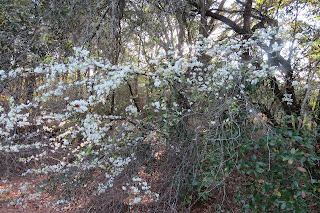Friend Maureen recommended this Park to me last year. Alas, I didn't get there until January 14th, 2017. It did not disappoint! The Park was the first State Preserve in Florida in 1971, and it is now recognized as a National Natural Landmark. The northern part of this 21,000 acre mixed marsh-lake-savannah wonderland borders Gainesville, and a long bicycle trail in that university city. The south end is close to Micanopy Florida down highway 441.
We stopped first along 441 to view the Prairie, and found hundreds of Red-winged Blackbirds already nesting in the marsh. We proceeded to the north entrance, location of the visitor center, obtained information and brochures, and then hiked to the high lookout tower. Vistas seem endless. I could see a few Sandhill Cranes, wild horses, and a Black-crowned Night Heron.
I also had good view of many other wading birds like the Great Egret, above, and the Great Blue Heron, below.
The day was waning, so we hurried to the LaChua Trail, in the Gainesville side of the Park. It being the weekend, the trail was filled with University of Florida students and their families. It was good to see so many younger people enjoying this natural place. This trail winds along ponds, lakes and wetlands 1.5 miles out to another observation tower overlooking the shallow Alachua Lake. The canals and ponds are rich in fish and a large population of American Alligators (see two photos below).
As I walked out to the Lake, the mud flats appeared on both sides of me, with so many Sandhill Cranes, Grus canadensis (above) shore birds, waterfowl and wading bird(see below)s, I had a hard time determining where to look. We Canadensis Snowbirds and the Cranes have a lot in common!
A number of the wild horses, originally brought by the Spaniards, were grazing peacefully nearby. Piles of horse hooey, horse hockey pucks, or whatever you call horse leavings, were the only hazard along the trail (aside from University of Florida students wearing various scents).
The mudflats hosted more and more Sandhill Cranes (the Crane calling din drowned out all other sounds) foraging for food in the mud until....
I noticed one crane that was all white, with both a red chin AND forehead (above and two photos below photographed from the observation tower). I now have seen a Whooping Crane in both Florida AND Texas!
But, the Sandhill Cranes dominate....thousands as far as the eye can see, along with egrets, ducks and wading birds.
These Yellow-legs were one of many shorebirds, like Sandpipers, Dunlin, Willetts and others.
Challenge: count the Sandhill Cranes in the photo above. The sun was falling, and, in theory, the Park closes before sunset. In reality, as long as you are on the trail before 5 PM, it is fine to continue to finish the 3 mile loop.
Therefore, with cranes, ducks, blackbirds and more flying overhead to various roosting spots, I was able to capture a stunning sunset over the Prairie.
I plan to go back and document all the birds along the LaChua Trail.
For more info:
https://www.floridastateparks.org/park/Paynes-Prairie
See you next time!
Art













































